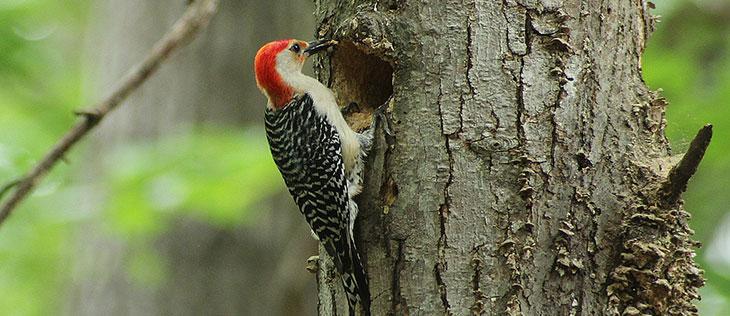
Why Do Woodpeckers Peck on Houses?
There are many reasons that woodpeckers may be pecking on your home or other wooden structures. They might be pecking to create a nesting cavity, looking for a mate, hunting for a meal, or even performing territorial drumming.
Some signs for each of these can help you better understand why these woodpeckers are causing house damage. If they are creating larger holes, this means they are looking to create a nesting cavity to store nuts and other items. This may not be the worst option as they are more gentle and meticulous when building their nesting cavities. If they are performing territorial drumming, it most likely won’t be on your wooden structures. Woodpeckers will peck better sounding items like metal trim & gutters to reverberate their drumming. That leaves us to our last option, which is most likely the worst, what could these winged species be hunting for?
What Do Woodpeckers Eat?
Carpenter bees are a favorite food of the ever-so-destructive Woodpecker. Did you think that carpenter bee damage stopped with the nest tunnels they built? Unfortunately it doesn’t. Woodpeckers absolutely love carpenter bee larva and will peck their way through a carpenter bee nest to get after their tasty treats. Bottom line - if a woodpecker is attracted to your carpenter bee nests and you haven’t handled them properly, the damage to your home can increase dramatically. The woodpecker is not diligent in this process like they are in building a nesting cavity, if they know the wood bee larvae is just behind your wood, they will do much more damage to receive their next meal.
How to Deter Woodpeckers
Preventing carpenter bees from nesting in your wooden structures is incredibly important to keeping those woodpeckers away. Being proactive in the spring, rather than reactive to their nests, is truly the best way to structural damage to your home. Hanging up carpenter bee traps at the beginning of the season - right as spring comes around - is ideal to prevent carpenter bees from nesting in your home. Having the trap up will catch the carpenter bees before they even begin sawing through your wooden structures and producing larva, making woodpeckers a non existent problem.
When Does Carpenter Bee & WoodPecker Season Overlap
If you are a bit behind this season and already see the carpenter bees at work, it’s okay! You can still win the battle, it’s just a bit more work.
Carpenter bees spend the first several weeks of their life finding a mate and exploring areas to nest. Once they pick the place for their home (usually when you start to notice them the most) they take some time to create the perfect quarters for the larva they lay. Carpenter bees will build back their nests about 2’ - 4’ each season and make chambers off of the tunnels to lay their young.
Filling in these nests and plugging them up will make it much harder for woodpeckers to find any larva. The woodpeckers usually are more prevalent in Spring & Fall, so it is important to treat your carpenter bee holes immediately in the spring when the wood bees have larvae. Treating the holes with a pesticide before sealing up the nests helps to kill the carpenter bees living there. Plugging up the nest after treatment to make it flush with the exterior will not only stop the carpenter bees from burrowing further, but also helps keep the woodpeckers away. Check out our article on plugging up carpenter bee nests here!
After plugging up the nests be sure to place a carpenter bee trap & supporting carpenter bee removal products in the area to catch any remaining carpenter bees looking to make a home. Following these simple steps are your best defense against further damage from woodpeckers.









Leave a comment
All comments are moderated before being published.
This site is protected by hCaptcha and the hCaptcha Privacy Policy and Terms of Service apply.